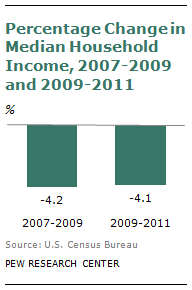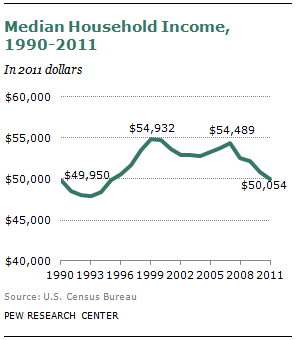
The median income of American households decreased by as much in the two years after the official end of the Great Recession as it did during the recession itself. The latest estimates from the Census Bureau show that the median income for U.S. households in 2011 was $50,054.1 In 2009, the year the Great Recession ended,2 the median income of U.S. households had been $52,195 (in 2011 dollars). Thus, in the two years since the end of the recession, median household income has fallen by 4.1%.
The decrease in household income from 2009 to 2011 almost exactly equaled the decrease in income in the two years of the recession. During the Great Recession, the median U.S. household income (in 2011 dollars) dropped from $54,489 in 2007 to $52,195 in 2009, a loss of 4.2%. By this yardstick, the recovery from the Great Recession is bypassing the nation’s households.
Recovery in Household Income Following Other Recessions
The current “recovery” is also the most negative for household income during any post-recession period in the past four decades. However, the failure of household incomes to regain ground two years into an economic recovery is not without precedent. U.S. households also experienced lingering losses during the recoveries from the 1990-91 and 2001 recessions—median household income fell by 1.3% in the first two years following the end of each of those two recessions. But those losses were less than half as great as the decrease of 4.1% in the first two years of the current economic recovery.

The nation also experienced prolonged recessions from 1973 to 1975 and 1980 to 19823 but household incomes began to recover immediately thereafter. The median household income fell by 5.7% in the 1973-75 recession but rose 2.3% in the first two years of the recovery. Similarly, the median income fell by 5.0% in the 1980-82 recession but increased 2.4% in the first two years of the recovery.
More than a Decade of Losses in Household Income

The continuing decline in household income means that 12 years have now passed without the median exceeding a previous peak. Estimates of household income from the Census Bureau are available starting from 1967. The highest level recorded for median household income since that year is $54,932 in 1999 (inflation adjusted to 2011 dollars). That was the end result of a record-long economic expansion in the 1990s.
The recession in 2001 triggered a significant decline in household income through 2004. As the recovery strengthened, the median household income in 2007—$54,489—stood at a level that was approximately the same as in 1999. However, the plunge caused by the Great Recession was swift and rapid. The median income in 2011—$50,054—was 8.9% less than its level in 1999.4
Other Indicators of the Wellbeing of U.S. Households
The lackluster results on household income are symptomatic of broader struggles in the economic well-being of U.S. households. As noted in the latest Census Bureau report, the poverty rate has also risen in the two years since the end of the Great Recession, from 14.3% in 2009 to 15.0% in 2011. The rate in 2007 was 12.5%.
Another financial burden on households is the nosedive in their wealth (value of assets owned minus outstanding value of debt) due to the recession. The latest available estimates from the Board of Governors of the Federal Reserve System show that median household wealth fell from $131,016 in 2007 to $79,431 in 2010, a loss of 39%.5
The malaise in income, poverty and wealth in part reflects the weak performance of the U.S. labor market. The share of families with at least one unemployed member nearly doubled during the Great Recession and remains at a high level. In 2007, 6.3% of the nation’s families had at least one unemployed member. That share jumped to 12.0% in 2009 and declined modestly to 11.5% in 2011.6
At the more personal level, the unemployment rate increased from 4.6% in 2007 to 9.3% in 2009 and only edged down to 8.9% in 2011. Not only does unemployment remain high, those who are unemployed remain without work for long periods of time. The median number of weeks people are unemployed climbed sharply from 8.5 in 2007 to 15.1 in 2009 and then elevated further to 21.4 in 2011.7
Overall, on the basis of some indicators, such as income and poverty, the economic health of American families deteriorated further in the first two years of the recovery from the Great Recession. Other indicators, such as unemployment, showed minimal improvement, if any. Much like an unwelcome dinner guest who does not know when it is time to leave, the Great Recession seems blissfully unaware that it was declared over in June 2009.




